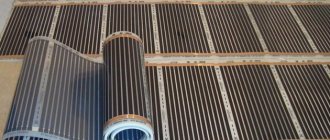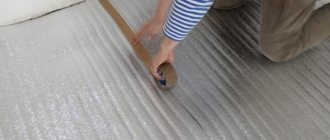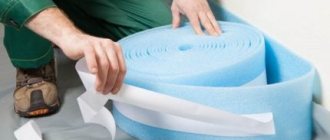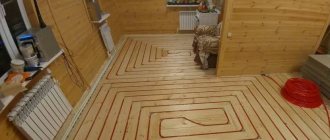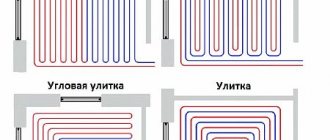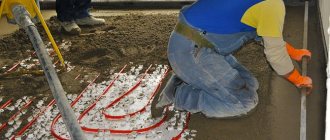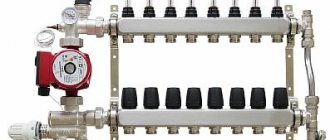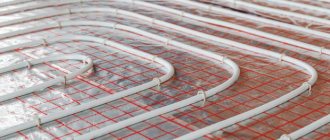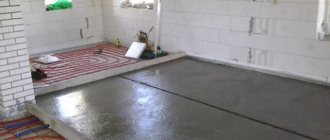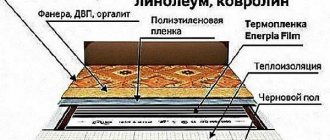Floor insulation is necessary to reduce heat loss both after laying a heated floor system and during installation of the finishing coating. Now there are many types of this useful material on the market, but foil floor insulation is recognized as the leader among them. How to choose the right foil insulation? What are the nuances during installation? We will answer these questions in our article.
Foil insulation for floors
Foil insulation
Structure of foil thermal insulation material
Most types of foil-coated thermal insulation materials are produced in rolls, which ensures ease of use during installation work.
In general, most insulation materials have a two-layer structure - base and foil. The basis can be:
- basalt;
- mineral;
- polystyrene foam;
- polyethylene.
Each of these materials is environmentally friendly, safe for health due to its inertness, and has excellent fire safety performance. Also, most types of base have a bubble structure, and air, as you know, is one of the worst conductors of heat.
The foil layer is a foil made of aluminum, the role of which is to directly reflect thermal energy. It allows the returned heat to be evenly distributed, but the base prevents it from going into the screed.
On a note! Foil insulation is mostly elastic and soft materials, so the installation process is quite simple.
Due to the fact that most thermal insulation materials with a foil layer can withstand heating up to +90 degrees, such substrates can be used for any type of underfloor heating systems. By the way, on the surface of the foil insulation there are often markings that facilitate the process of laying the cable - you don’t have to constantly fiddle with a tape measure. With this material it is also easier to install a water floor system. Another feature of some foil materials is the sticky layer. It allows you to fix the insulation in one place during installation and will not allow it to move.
How is thermal insulation performed with isolon?
Insulation of the floor in a house made of timber can be done in three ways. Below we will look at each option separately.
First way
Extruded polystyrene foam slabs are laid on the leveled ground, and the seams between the sheets are foamed with polyurethane foam.
A concrete screed is placed on top of the insulation. It is necessary that the concrete base is level, without cracks or other defects. If there are cracks, they must be filled with putty and then sanded.
After cleaning the surface from dust, rolls of isolon are placed on it (the protective film must first be removed from the material), which are fixed to the floor with glue or dowels. The sheets are glued together with foil tape.
Second way
The pre-leveled soil is covered with a waterproof membrane, then mineral wool slabs are placed on it. A waterproofing film is also laid on top. The lower hydromembrane protects the insulation from moisture coming from the ground, and the upper one does not allow it to enter the room.
Floor joists are installed on which boards are laid. The floor is insulated on top of them. Isolon is spread over the insulated surface and secured with a stapler or screwdriver. The joints are sealed with tape with a foil layer. Then the floor covering is laid.
Floor insulation along joists:
- Remove old flooring.
- Lay wooden logs on the rough base at a distance of 600-1000 mm from each other. Before laying, beams must undergo antiseptic treatment to prevent rotting.
- Between the lags, boards or plywood sheets are laid on special cranial bars.
- A layer of waterproofing is laid on the prepared wooden base, and then sheets of insulation are laid out so that the upper edge of the material is lower in height than the joist. Izolon itself has vapor barrier properties, so there is no need to lay a vapor barrier film on top.
- A finishing flooring is laid on top of the heat insulator. To arrange it, boards more than 3 cm thick or sheets of plywood are usually used, which are laid in a perpendicular direction to the beams.
- The finishing floor covering is laid on top of the insulated base.
Is underfloor heating insulation necessary? Do you need foil?
| Installation of heated floors follows the same recipe. The first step is to install edge insulation and lay foam. This is necessary so that the heat goes up, i.e. so that the pipes or cable heat your floor, and not heat your neighbors’ ceiling. Some installation organizations recommend laying so-called foil foam on top of the foam, i.e. polyethylene insulation covered with aluminum foil. This is argued by the fact that, firstly, foam a few millimeters thick provides additional insulation, and secondly, the foil is needed to reflect heat rays upward from its surface. Is this really so and how advisable is it to use such foil? Let's consider the first consideration: additional insulation with foam under the foil. The thickness of the main insulation - polystyrene foam or polystyrene that is laid on the floor covering, must be at least 3 cm for interfloor ceilings, and 5-8 cm for floors on the ground or above basements. An additional 1-2mm of foam under the foil will give an increase in heat transfer resistance of about 1-5%. Does it make sense to buy this kind of insulation and pay for the flooring if the insulation improves so little? No. If there is such a need, then it will be cheaper to lay thicker foam. The second argument: the foil in the screed acts as a mirror for “heat rays”, reflecting heat upward and not letting it down. As an example, thermoses are sometimes cited, where a flask with hot water is lowered inside another flask, which has a mirror coating on the inside. Substrate for heated floors purpose and types Let's consider this consideration. We'll have to remember a little physics, but we can handle it. Heat in nature can be transferred in three ways:
|
The key point necessary for the transfer of heat by radiation is this. The medium in which such heat transfer occurs must be transparent. The sun will not warm you underground (sorry for the gloomy analogy). Rays of any spectrum, incl. infrared, do not pass through concrete. There is no heat transfer by radiation inside the concrete screed. Foil cannot reflect anything inside the heated floor structure. Therefore, the foil itself inside the floor screed does not make sense.
In addition, concrete very quickly corrodes zinc, foil, and metal in general. Do an experiment. Take a piece of such insulation and spread it with a thin layer of concrete, which after a couple of days will be easy to wipe off with a rag. Look at what will be under the concrete in a couple of days. You will see that the foil is no longer there. The cement will eat up the entire reflective coating in just a few days. Therefore, none of the arguments presented in favor of using foil foam or its analogues stand up to criticism.
If our arguments seem insufficient to you, then look at another method of laying underfloor heating pipes, which is offered by almost all manufacturers of components for underfloor heating.
These are polystyrene profiled slabs with “stumps”, between which a pipe is laid. Concrete is immediately poured over such mats; there are no reflectors there, and this is considered a higher quality and professional solution than just foam plastic. Thus, you should not overpay for foil insulation when installing heated floors. Compared to the general background, its cost is not very significant, but since it is completely meaningless, it is not worth doing it. And the wide open jaw of the installers when you tell them all this will give you a lot of pleasure.
Izolon under plywood on the floor. isolon
evgeny
Report to moderators
This method (under plywood) of laying isolon is quite acceptable when installing floor coverings. In addition to plywood sheets, on top of this heat-; soundproofing material can be laid parquet, laminate or linoleum.
KuPer
Participant
KuPer
Report to moderators
In principle, it is possible, but it will be of little use. The main advantages of isolon are low density and high porosity, which is why it is considered a good insulation material. It works great on walls, but under a load of plywood? A simple, crumpled sandwich made of plastic and foil. The styling effect is almost zero.
1
Kiril
Participant
Kiril
Report to moderators
I completely agree with evgeny. There is isolon, the density of which is designed specifically for floor insulation. But I would advise you not to take anything you come across, but one made of sewn polyethylene and with a self-adhesive bottom base.
Root
Forum member
Root
Report to moderators
Isolon is fine, but I repeat about plywood - do not lay layered or fibrous materials on the floor. Plywood and fiberboard behave unpredictably, you will curse everything from taking furniture out of the house, tearing down and redoing floors. And this happened more than once or twice with plywood on the floor.
evgeny
Newbie
evgeny
Report to moderators
Root: January 27, 2016 at 11:52 pm
on (expand)
Isolon is fine, but I repeat about plywood - do not lay layered or fibrous materials on the floor. Plywood and fiberboard behave unpredictably, you will curse everything from taking furniture out of the house, tearing down and redoing floors. And this happened more than once or twice with plywood on the floor.
Agree. If you have already placed Isolon on top of a wooden floor, then you can safely put flooring on top of it (linoleum, laminate, parquet). An extra layer in such a “pie” (plywood) can only do harm.
Artemus
Participant
Artemus
Report to moderators
evgeny: January 28, 2016 at 10:13
on (expand)
Agree. If you have already placed Isolon on top of a wooden floor, then you can safely put flooring on top of it (linoleum, laminate, parquet). An extra layer in such a “pie” (plywood) can only do harm.
Plywood will not harm, it will be easier to lay parquet or laminate on it later, plus the plywood layer in the cake will provide greater sound insulation. The downside is that the height of the room may decrease slightly depending on the thickness of the plywood sheet.
Root
Forum member
Root
Report to moderators
Laminate flooring will make a knocking noise against the plywood when you walk on it. The plywood will bend, the laminate will bend at least a little, and the whole thing will rattle underfoot. It is advisable to lay the laminate on a soft (but not thick) substrate.
Features, types and characteristics
Connecting a heated floor to a thermostat
Thanks to the foil, this combined material reliably retains heat in the room and has a heat- and water-repellent effect. Foamed penofol, in turn, has a porous surface that perfectly retains heat and acts like a thermos. The material, although it has several layers, is thin, so when laid on the floor it does not reduce the height of the room.
It is ideal to place it on the first floors, under which there are basements, as it does not allow the cold and dampness emanating from them to pass through. Foil insulation is often used for floors with a concrete base, saunas and rooms that have a “warm floor” system.
Varieties
When purchasing such material, you need to check its heat-reflecting layer; it may have an aluminum coating or be made of foil. Some manufacturers, trying to reduce the cost of the material, spray a thin aluminum layer on its surface, so the quality of the insulation deteriorates.
Types of heat insulators differing in design and purpose:
- Foiled polystyrene foam. It is used exclusively for floor insulation. It is made in the form of steel-colored layers with great thickness. On photo-foil polystyrene foam
- Foamed polyethylene. It is most often used for insulation of ventilation and sewer systems, as well as for walls and floors. Manufactured in the form of rolled material with aluminum coating. Photo-foamed polyethylene
- Basalt foil insulation. This type is highly resistant to external influences; it is even used for gas stations. The material can withstand temperature changes ranging from -200°C to +700°C. The photo shows basalt foil insulation
- Mineral wool with foil. Sold in rolls, which are most often used for insulating roofs, pipes located on them, floors on balconies and bathhouses. The photo shows mineral wool with foil
The most popular are roll-type insulation materials made from foamed ethylene foam. Almost all of them are produced under the same brand - Penofol.
They have their own qualifications, depending on the location of the foil layer on them, there are four types:
- Type “A” is the classic variety, which has foil on only one side.
- Type “B” is a dense material with welded foil on both sides.
- Type “C” - it has foil on one side and a self-adhesive base on the other.
- Type “ALP” - comes with one foil layer, which is laminated with polyethylene.
What names of insulation with foil exist and in what area of construction they are used are described in detail in this article.
Depending on the structure of penofol, there are several grades that are suitable for laying on the floor:
- Penofol 2000 A - there is a foil layer on its outer surface. For installation in rooms with high humidity, it is necessary to install waterproofing on top of it. Its analogues with the letters “B” and “C” are reliably protected from moisture, so they do not require an additional protective layer. For photo-penofol 2000 A
- Penofol ALP - used for “warm floors” powered by electricity. After the rolled insulation is placed on top of it, a screed is performed. Its foil layer is covered with a special protective film, which makes the material resistant to damage. On photo-penofol ALP
- Penofol C is a classic version of foil insulation. On photo - penofol C
- Penofol 2000 R – the material has a smooth and embossed side, the foil is located on the latter. For photo-penofol 2000 R:
- Penofol Super NET retains heat better than other types and has a long service life. It is available in three types: A, B and C. It has good characteristics, as it has a special structure, which consists of canvases, and a polyethylene foam mesh is located between them. For photo-penofol Super NET:
- Penofol 2000 M - should be placed in several layers, since the foil layer on it is on the smooth side, and the embossed one remains open.
Laying and installation of profile mats with bosses
Let's look at how to install a heated floor using polystyrene foam mats with bosses.
Step 1. First of all, you need to prepare the surface to be equipped
So, in the room where the heated floor will be installed, it is important to level the base so that height differences at a distance of 1-2 m are quite insignificant. It is also recommended to carry out waterproofing measures first - for example, apply a special mastic
The base needs to be prepared
Step 2. Next, lay a layer of dense thermal insulation material - this can be polystyrene foam, polystyrene foam. Laying is done without gluing joints - simply the sheets are laid tightly and without gaps.
Laying thermal insulation material
The joints do not stick together
Step 3. If necessary, the material can be cut with a regular sharp knife. This may be necessary if, for example, in the last row of insulation, solid slabs do not fit into the remaining space due to their size.
Slab cutting
Step 4. Next, you need to attach a damper tape to the wall along its perimeter. It is necessary in order to avoid deformation of the screed in the future. You can buy damper tape ready-made, or you can cut it from porous material. The easiest way to fix it in this case is with self-tapping screws.
Attaching the damper tape
Additional functions of damper tape
Step 5. Then begins laying the mats with bosses. They have special locks for joining individual sheets together. The sheets are stacked so that the rows in them coincide with each other.
Laying mats with bosses
Mat laying process
Step 6. For each sheet that will run along the wall, the lock on the wall side needs to be cut off. You can also trim it with a sharp knife.
The lock is cut
Step 7. If necessary, the mats can also be cut to the required size, for example, for laying in the last row. They should lie in a dense, continuous layer.
Trimming mats
Step 8. Then you need to drill holes in the walls through which the pipes for the heated floor will be brought into the room. The holes must be made of a certain diameter - to match the diameter of the pipe. And they are made immediately above the level of the mats.
Next, holes are drilled
Step 9. The heated floor pipe needs to be pushed into the hole in the wall from the side of the room in which preparations are being made for installing a heated floor. Next, it will need to be connected to the collector when the circuit itself has already been laid.
The pipe is pushed into the hole
Step 10. After this, you can form the thermal circuit. The pipes are laid between the bosses, in this case with a step of 20 cm between individual rows. It is required to form a snail-type styling.
Pipe laying
Formation of the thermal circuit
Step 11. When the first row is laid, you need to start laying the second, which is formed from the same pipe. In the center of the room you need to start laying it in the opposite direction - the water will circulate along the circuit and return to the boiler room for the next heating.
Laying the second row
Step 12. In general, you should end up with a picture like this. The second end of the pipe should also be pushed through the hole in the wall into the boiler room, having first measured the amount of pipe - there should be enough of it so that in the boiler room it is possible to connect the pipe to the collector.
The result should be the following
Step 13. After this, you need to supply water and check the system for functionality. If no problems were noted anywhere, then you can make a cement screed. The screed is done according to the level - the result should be a horizontally level base. By the way, you only need to fill the screed when the pipes are filled with water. Otherwise they may be deformed.
Cement screed device
The base should be level
Step 14. After the screed has been made, it must be dried for 28 days. After this, you can carry out further work on home improvement. But at the stage when the screed dries a little, it can be sanded using a special grinding machine. This procedure will make the base as smooth and neat as possible.
Grouting cement screed
Types of thermal insulation
Penofol
Thermostat for heated floors
Penofol is produced and sold in the form of rolls.
Penofol is foil-coated polyethylene foam. It is a soft and flexible material produced in rolls.
Thermal conductivity coefficient is 0.037 – 0.052 W/m×°C.
Penofol is easy to install and easy to cut. The foil layer effectively distributes heat over the entire surface of the heated floor.
However, this material also has a drawback: under the weight of the screed and floor covering, it can shrink, while the volume of air bubbles included in its structure will significantly decrease, which will entail a loss of thermal insulation qualities.
Important! As a rule, this material is used on the upper floors of apartment buildings, where there is a warm heated room under the heated floor, and the floor slab is sufficiently heated. . This material is not suitable for basements and first floors, as well as balconies and loggias, basements and garages.
Sometimes, however, it is not possible to raise the floor a significant distance, then the use of penofol may be justified.
This material is not suitable for basements and first floors, as well as balconies and loggias, basements and garages. Sometimes, however, it is not possible to raise the floor a significant distance, then the use of penofol may be justified.
Advice! When choosing floor insulation, look for foil materials with an aluminum foil thickness of at least 30 microns. We are not interested in lavsan coatings with reflective properties, only thick foil!
Cork tree
Balsa wood insulation is sold in rolls, sometimes in the form of mats or slabs.
The thermal conductivity of balsa wood ranges from 0.035 – 0.05 W/m×°C. As you can see, this characteristic is comparable to that of penofol.
However, it is believed that a layer of cork 2–3 mm thick is sufficient to insulate a heated floor. This is certainly a controversial opinion.
The advantage of cork insulation is its naturalness. It consists of absolutely natural raw materials and does not emit toxic chemicals under any conditions.
However, there are also disadvantages:
- high price of material;
- the possibility of rotting, a breeding ground for fungi and mold;
- damage from biological corrosion;
- the cork needs waterproofing.
Therefore, for cork wood we can also conclude that it is only suitable for floors with minor losses and warm heated floors. More often, cork is used as a substrate for laminate flooring.
Expanded polystyrene
Foiled polystyrene foam for thermal insulation of floors with markings.
Expanded polystyrene is the most acceptable option for thermal insulation of floors.
This is caused by a number of reasons:
- The material has a density sufficient for laying under the screed - more than 35 kg/m³;
- Expanded polystyrene slabs have sufficient thickness - 50 mm, thanks to which you can easily arrange effective 100 mm thermal insulation of the floors of basements and basements, first floors, etc.;
- The material has low thermal conductivity - 0.039 W/m×°C, which with a layer of 50 - 115 mm provides complete insulation and reduces heat loss to nothing;
- Expanded polystyrene for floors is covered with a laminated layer of foil from 30 microns thick, which makes this type of insulation optimal;
- The installation instructions suggest simple DIY work, and markings on the foil make it easier to install the heating elements;
- The slabs do not shrink under the weight of the screed and maintain stable thermal conductivity for many years;
- Polystyrene is chemically inert to solutions of salts, acids and alkalis;
- The material is biologically inactive and is not food for living organisms or a substrate for fungi;
- Does not change parameters and does not emit harmful chemicals in the temperature range from – 180 to +180 ° C.
Advice! When purchasing a thermal insulator based on polystyrene foam, look for flooring material, since facade and other configurations may not be suitable for working near heating elements and emit harmful substances or change their parameters and shape.
Expanded polystyrene is especially convenient for warm water floors if it is equipped with special locks for securing the tubes.
Important! According to most experts, it is extruded polystyrene foam with a density of 35 kg/m³ that is the best means of thermal insulation for heated floors, especially on the ground floors and in the case of unheated rooms below.
Foil insulation for floors
The variety of products in construction stores is very large and it is extremely difficult not to get confused among the entire assortment and choose a truly high-quality, effective material, the use of which will not force you to soon redo all the repairs, but, on the contrary, will give you the joy of the fact that it was carried out using high-quality materials .
What is reflective insulation
Foil insulation is a relatively new material on the market. Previously, the category of insulation for floors, walls, and roofs was represented by one single type - mineral wool, which had a lot of disadvantages. This material gets wet, and when in contact with water it loses most of its properties. At the same time, working with it was difficult due to unpleasant tactile sensations, and sometimes dangerous.
Mineral wool
Foil insulation is a two-layer material, most often supplied in rolls, but is sometimes also found in the form of slabs. Layers are represented:
- directly with insulating material, such as polystyrene foam, polystyrene foam, penofol, etc.;
- foil on a layer of insulation, which has certain heat-reflecting qualities.
On a note! Foil insulation has special properties precisely due to the presence of a foil layer. It has the ability to reflect thermal energy and direct it inside the room, preventing it from escaping outside, strictly limiting the area of heat distribution.
Foil floor insulation consists of two layers
Also, material covered with foil does not get wet, which means it also has certain water-repellent properties, although it cannot be used as a waterproofing coating.
Depending on the type of material from which this type of insulation is made, it can be thick or thin, retain heat worse or better, have pores of different sizes, which contain air in one quantity or another.
Polyethylene foam
Types of foil substrates
Currently, a large number of models of insulation with foil are sold; they have different bases and are intended for different construction work.
Folgoizol
Underfloor heating made of foil insulation is most often used for the construction of baths and saunas. After all, the main advantage of folgoizolon is that it is not afraid of water and sudden temperature changes. The service life is long, since the product is not subject to rotting.
The material is environmentally friendly, has enhanced sound insulation properties, and is able to withstand mechanical loads. But due to its high cost, it is practically not used as insulation for residential premises, with the exception of luxury housing.
Basalt insulation
Basalt wool is the leader among insulation materials. It has low thermal conductivity and tolerates temperature changes well, in the range from -200 to +700 degrees. This type is equipped with a reflective surface, does not burn, and the installation process is simple.
Despite the fact that the insulation is not susceptible to heat, it is not recommended to use it in underfloor heating, since heating may release harmful substances.
Minvata
Mineral wool with a layer of foil has excellent thermal insulation properties, in addition, it is fireproof. However, the composition contains components that, when heated, release harmful substances, therefore it is contraindicated for warm systems.
It is also not suitable for places with high humidity, since cotton wool loses its properties when saturated with water. It is recommended for industrial premises.
Polyethylene foam
Polyethylene fabric with a foam structure and a reflective surface is considered the most popular type of insulation. Polyethylene with foil is suitable for both water-heated floors and cable floors.
Foamed polyethylene has good ductility and increased strength. The material is resistant to moisture, is not affected by chemicals, absorbs noise well, and does not contribute to the development of microorganisms. The service life of this type is long.
On the front side, the product is made of foamed polyethylene and has a Mylar film with a metallized coating. The reflective surface ensures uniform heat distribution, and the foam base with air cells does not allow warm currents to flow into the concrete screed.
For your information! Foamed polyethylene is afraid of ultraviolet radiation, but the finishing coating protects it from the penetration of sunlight.
Expanded polystyrene with foil
Expanded polystyrene covered with foil is a popular thermal insulator for heated floors: water and electric. It is inert to chemical attack and quite durable.
In addition, it can withstand temperatures from -180 to +180 degrees, although such temperatures are not required in everyday life. The product does not rot, does not contribute to the development of harmful microorganisms, and, therefore, does not harm human health.
Multifoil
Multifoil is a canvas made of many layers. A foiled aluminum layer with chambers filled with air, and the base of the product is polyethylene or propylene film. The bubble layer allows you to reduce heat loss to a minimum.
The insulation of this model is not susceptible to moisture, has a high thermal insulation potential, and increases the efficiency of the heating system.
Expanded polystyrene
Thermal insulation, in addition to the function of preserving heat, distributes it evenly over the surface and directs the flow of warm air upward. More often than others, polystyrene foam is used for this.
Expanded polystyrene is produced with a foil surface and applied markings
It is a close relative of polystyrene foam. During its manufacture, the strength and density of the material were improved. Can also be manufactured with a laminated surface to prevent exposure to harmful chemicals.
The material is produced in the form of slabs of various thicknesses. Since it consists of cells filled with air, it has good sound insulation and low weight, which greatly simplifies its installation.
Each master can select expanded polystyrene according to his selection criteria. For laying on the ground or cold basement floor, choose a thickness from 80 mm to 120 mm; between floors, 30-50 mm is sufficient.
Manufacturers offer many manufacturing options:
- smooth;
- foil;
- with bosses;
- with grooves.
The choice of insulation used depends on the skill of the craftsman and his material capabilities. The more expensive the price of the material, the easier it is to work with it.
Smooth polystyrene foam is the cheapest and most popular insulation material. It can even be laid on tightly compacted gravel.
When installing this type of material, it is necessary to additionally use a foil covering over the slab. It will allow the heat to be evenly distributed over the entire surface of the floor, and not heat only directly near the pipes. Plates are produced immediately covered with foil.
Foil promotes uniform heat distribution over the entire surface
It is also necessary to mark and install various guides for laying pipes. There is a large selection of components for this on sale. An experienced master will easily cope with the task.
Insulation for water heated floors is available in the form of slabs. All joints and seams must be taped with metallized tape to retain heat. The heated floor is separated from the walls by a damper tape to compensate for temperature stresses.
To simplify the work, polystyrene is produced with an aluminum coating, applied markings and ready-made joining folds. There is polystyrene divided into sections with a common foil covering. All this greatly simplifies installation, but increases the price.
The use of laminated polystyrene foam boards with bosses or grooves will help to avoid markings, foil, and reinforcement.
They have a number of significant advantages:
- higher strength;
- surface lamination to protect against moisture and harmful chemical influences;
- bosses or grooves provide easy marking and installation of pipes;
- the slabs are equipped with side locks for better joining;
- practically do not deform under the weight of the pipes.
When installing this system, you only need to level the base and cover it with a layer of film. All other manipulations are greatly simplified.
Using bosses you can easily make any pipeline design. May be interesting
The advantages of the material also include its immunity to fungi and the dislike of small rodents. The material is durable and environmentally friendly.
Laying slab material
Reflective thermal insulation in slabs
Reflective thermal insulation in slabs is installed primarily under heated floors, although it can also be used as regular insulation. With foil mats, make a floating screed and lay them between the joists.
Floating screed
Step 1. The concrete surface of the floor slabs is leveled using putty and grinding. Clean from dust.
Step 2. Using a level gauge, mark the screed pouring line on the walls.
Step 3. A damper tape is attached to the walls around the perimeter of the room and the base is primed.
Kermi damper tapes
Step 4. Plates are taken with a metallized coating, since aluminum is corroded by cement. Glue is applied pointwise to the base of the mats, after which the insulation is laid on the floor with the reflective layer facing up. When laying insulation, carefully adjust the joints so that gaps do not form.
Step 5. The joints are taped, and then the heat-insulating layer is filled with screed mortar. Level the mixture with a wide spatula or rule and leave until dry. After this, you can lay the finishing coating.
Insulation by joists
Step 1. Remove the floor covering, clear the base of debris, check the integrity of the joists, and, if necessary, repair damaged elements.
Step 2. Place waterproofing material on top of the joists and secure it with a stapler on the inside of the beams, spreading the film well on the floor. The edges of the canvases are overlapped by 10-15 cm.
Step 3. The space between the logs is filled with foil plates, laying them in one or two layers. The slabs of the second layer must overlap the seams of the lower layer. A gap of 1.5-2 cm is left between the reflective coating and the upper edge of the logs. If it is not possible to leave a gap, a sheathing of 20x40 mm slats is placed on top of the logs.
Foil basalt mats
Step 4. Further actions depend on the type of flooring. If it is linoleum or laminate, the rough base is covered with sheet material - plywood, chipboard, OSB. If the floor is made of boards, they are placed directly on the joists.
Selecting a Finish
The best floor covering for a “warm floor” system is ceramic tiles (or porcelain stoneware). It has sufficient strength and does not emit harmful substances when heated.
The only disadvantage of ceramics – the coldness to the touch – disappears, so the combination of warm floors/tiles is ideal for the kitchen, bathroom or balcony.
One of the options for installing a water heated floor, made according to a standard scheme: layers of hydro- and thermal insulation are placed on the base, pipes are fixed on top of a metal mesh, which are filled with concrete mortar. Design of a wet heated floor, indicating all layers, possible types of material and sizes. The finishing coating can be porcelain stoneware or ceramic tiles, as well as linoleum, laminate or carpet with special markings
Rehau PE-Xa cross-linked pipes are characterized by optimal flexibility. For ease of installation, the products are equipped with axial fittings. Maximum density, memory effect and fittings with sliding rings are excellent characteristics for use in underfloor heating systems. For ease of maintenance and additional protection, the manifold and mixing unit is placed in a cabinet located in an accessible place. It can be disguised in a niche, built-in closet or dressing room, or left open. Two ways of laying the circuit: “snake” - simple, but with a noticeable temperature difference at the beginning and end of the circuit; “snail” is more difficult to install, but it allows you to lay the heating circuit with a minimum pitch and solve the problem of insufficient flexibility of pipes. The graph, relevant for a system with a 70 mm screed and a tiled covering, demonstrates the dependence of the heat flux density on the average temperature of the coolant. Solid lines are pipes with a diameter of 16 mm, dotted lines are 20 mm (+) Installation diagram on the ground (from bottom to top): soil base (150-200 mm); crushed stone (80-100 mm), sand (50 mm); rough screed for leveling; waterproofing (polyethylene film), insulation (extruded polystyrene foam 50-70 mm); finishing screed with reinforcement and pipesExtruded polystyrene foam is sold in the form of slabs (dimensions 60 cm x 125 cm and 50 cm x 100 cm) with side grooves to facilitate the installation process. The thickness can be different - from 2 cm to 10 cm. Standard sizes of high-density polystyrene foam profile mats are 50 cm x 100 cm and 60 cm x 120 cm, thickness - from 1 to 3 cm. Price - from 270 rubles. up to 600 rub. for 1 m²
Harpoon brackets are installed along the entire length of the pipeline, at intervals of 4-5 cm (at turns - up to 10 cm). Approximate calculation: for every 100 m of highway - 250 staples. To fix the disc dowels, you must use a hammer drill with a long drill and a hammer. When laying insulation in two tiers, dowels are used to fasten both layers at once; a material with increased rigidity is used to construct the top layer. Before laying the pipe, the sections leading to the contour are placed in a heat-insulating “jacket” to retain heat. In the circuit (in the insulation layer) the pipe is located without additional thermal insulation, and at the outlet it is again placed in the corrugation. A cheap replacement for the damper tape is ordinary polystyrene foam, cut into narrow strips 10-15 cm wide and 1-2 cm thick. It is fixed to the wall using liquid nails , glue or polyurethane foam A correctly formed “pie”: the pipes are laid on thermal insulation and protected on top with a reinforcing mesh, which increases the strength of the screed and gives stability to the structure. Do not forget that the solution will be poured through pipes under pressure. The working pressure must be stabilized, for example, brought to 2 bar (the norm is from 1 to 3 bar). The tiles will be laid on a pre-prepared base - a leveled concrete screed, so a thin layer of tile adhesive is sufficient for fixing
If you plan to decorate the interior with practical linoleum or beautiful carpet, then when choosing coatings, be sure to pay attention to the markings: products intended for heated floors are marked with the appropriate sign
Application
But, although it is still possible to create the desired temperature, maintaining it at a certain level is not always possible. This is where insulation comes to the rescue.
In order to make a good thermal insulation for a steam room, you need to choose the right type of insulation. The market will offer many types of insulation, but not every type of insulation is suitable for a steam room, as for the entire bath. High humidity and temperature will negate the properties of many insulation materials.
But, despite the harsh environmental conditions, there is a choice. To make the right choice, you need to understand what role the insulation should play.
There are few of them:
- Firstly, the main thing is to keep warm. To do this, it is enough that the insulating material acts as a heat reflector and has low thermal conductivity.
- Secondly, insulation must be durable, environmentally friendly and affordable. Aluminum foil meets all these requirements. It has proven itself much better than traditional insulation materials such as roofing felt, glass wool, glassine and a number of others. Judging by the reviews of those who have already insulated their baths and saunas with foil, the best heat insulator does not yet exist in nature. The photo shows a sheet of foil-isolon. When installing thermal insulation sheathing, it is successfully used not only for insulating walls. It is possible, and even desirable, to insulate the ceiling. Thus, if you cover the walls and ceiling of a bathhouse with this insulation, then the issue of heat loss will be resolved once and for all.
In construction practice, there is another method of insulation using aluminum foil. Insulation is made using traditional materials, but a layer of aluminum foil without lining is spread over the top. But, given the “delicacy” of this material, it is advisable to purchase foil with a lining, for example, made of fabric.
If you cover them with aluminum foil, the insulation effect will increase significantly. In this case, the foil will create a reflective effect and the heat in the room will be reliably retained. And the layer of insulation located below will hold it in place.
The foil is attached to the insulation using buttons, furniture nails or using a stapler. The joints of sheets or strips are additionally glued with construction tape or aluminum tape. Whether this is worth doing is still an open question.
Some experts are against sealing joints, citing the fact that when heated, the adhesive tape releases toxins, to put it mildly, which are not very healthy. In their opinion, it is necessary to overlap the joints when installing them. But here, as they say, as many builders as there are so many opinions. One thing is known for sure - the heat-reflecting ability of the foil does not decrease from the method of sealing joints.
Floor insulation with isolon in a private house. Insulation of ceiling and floor with Izolon
Metallized lavsan film Izolon.
The simplest option for insulating a floor with Izolon is to use it as a lining under a laminate, although it is also possible to lay linoleum on top of foamed polyethylene. In addition, this material can be used in structural elements of a building, for example, on the ceiling and wooden floor laid on joists. The installation technique in both cases is very similar, so we will consider them together.
Naturally, Izolon thermal insulation as an independent insulation gives insignificant results, since its thickness is too small. Therefore, in order to get a high-quality thermal insulation cake, you need to use more solid insulation materials, for example, mineral wool. In this case, in addition to auxiliary protection against heat loss, foamed polyethylene can act as a vapor barrier. Mineral wool, especially glass wool, is prone to absorbing moisture from the air, especially if it is laid on the ceiling. Therefore, insulating the ceiling with Izolon in some cases is not only desirable, but necessary.
Correct insulation method:
- Mineral wool is laid between the floor or ceiling joists;
- Izolon is tensioned along the joists;
- the counter-lattice is stuffed;
- finishing is being installed.
It is quite acceptable to lay this material directly under the finishing, as sound insulation. To do this, it is enough to secure the material with a construction stapler on the working surface end-to-end and seal the joints with tape. If it is technically possible, it is better to leave a gap between the polyethylene foam and the finish. Even if there is moisture on the insulation, it will successfully evaporate and will not be absorbed into the finishing materials, which will significantly extend their service life. Many people are interested in the question of whether it is possible to insulate the floor with Izolon in a wooden house. This is allowed, but again, as independent thermal insulation, it gives almost no results.
Rigid thermal insulation cylinders made of mineral wool are used to insulate communications.
You can read about which non-flammable insulation materials for roofing are best here.
Types of thermal insulation with foil
So, on the building materials market you can find a variety of types of thermal insulation materials covered with foil; in particular, it could be:
- foamed polyethylene;
- expanded polystyrene;
- basalt insulation;
- mineral wool;
- multifoil;
- foilisolone.
Let's take a closer look at them. The most popular thermal insulation material used for heated floors is foil polystyrene foam. Quite durable material that is not afraid of sudden temperature fluctuations. In general, it is able to cope with changes in air temperature from -180 to +180 degrees without damage, but, of course, in domestic conditions the floors definitely do not heat up to that extent. Also, polystyrene foam is not afraid of exposure to various chemicals. It is not afraid of rot, various pathogenic microorganisms do not settle on it, which also demonstrates the material as safe for human health.
Mineral wool is purchased and used much less frequently, even with a layer of foil. It is especially not suitable for installing a water heating system. The fact is that in the event of a liquid leak, the material will easily become saturated with it and lose all its qualities - it will not be able to retain heat. And it is not recommended to use mineral wool for electric heated floors. The main reason for negative reviews is that this material, when heated, begins to release substances that negatively affect the body. Therefore, such insulation is often used only in industrial facilities. In fairness, it is worth noting that mineral foil wool also has an advantage - a low fire hazard class.
Foamed polyethylene is another commonly used type of underfloor heating. Durable, plastic, not afraid of moisture, it is not afraid of various chemicals, and pathogenic microorganisms do not settle on it. All these advantages make foil polyethylene one of the best materials for thermal insulation. It can be used both under water heated floors and under electric floors, and its service life can be very long.
On a note! Foamed polyethylene also copes well with such tasks as noise absorption. Its main drawback is the fear of ultraviolet radiation, but under the floor covering sunlight will not reach the material.
Basalt insulation is not used in residential buildings. It is not afraid of sudden temperature changes and can easily withstand from -200 to +700 degrees, which is why it does not burn. This thermal insulation material is used in the aircraft industry.
Folgoizolon is often used in the construction/repair of saunas and baths, as it is not afraid of either moisture or sudden changes in temperature. The service life of the material is quite long, it does not rot, has increased sound insulation properties, and is safe from an environmental point of view. But foil isolon is very expensive, so it is practically not used in residential buildings.
There is another type of thermal insulation with a foil layer. It is known as multifoil and consists of several layers. The foil layer is covered with bubbles filled with air, then polyethylene and polypropylene film are laid. Under the foil layer there is a special protective coating. If you use this type of thermal insulation, heat loss will be reduced to a minimum. In addition, multifoil is not afraid of high humidity.
Attention! When installing a heated floor system, you should not use materials intended for insulating walls and other parts of the building. On the floor they will experience strong mechanical stress, and therefore can quickly lose their properties
Only use materials that are specifically designed for installation on the floor.
What method do we use?
For a long time we used the method of attaching pipes to reinforcing mesh. There were many reasons for this: price, lack of other offers and expensive delivery to order. Now we are bringing anchor brackets and securing the pipes with a tacker. This significantly speeds up the installation process. Difficulties usually arise when pipe lines run at close distances. The tucker does not fit into the gap between the pipes and our tucker often makes false alarms. It is still unknown whether this is a feature of all tucker machines or just ours.
Penoplex is considered one of the best floor insulation materials due to its technical properties. The technology for installing it, although it has certain nuances, is not highly complex, so anyone with minimal construction skills can perform floor insulation with penoplex.
Floor insulation with penoplex
Advantages and disadvantages
As mentioned above, a substrate with a foil surface is an excellent material for saving energy. In addition, foil has a number of other advantages, but there are also disadvantages.
| pros | Minuses |
| Does not affect the height of the floor, since the foil material is only 2-10 mm thick. | High cost is the main disadvantage. |
| It is not difficult to install, so even an inexperienced person can handle the job. | It is not recommended to use a mineral substrate with a metallized layer for heated floors, since toxic substances are released during the heating process. |
| It has soundproofing and waterproofing properties. | Using such a substrate in rooms with high humidity significantly reduces its service life. A foil-coated product is recommended. |
| Withstands heating up to +90 degrees and more. | Dissolves upon direct contact with cement. |
| Most products with foil are equipped with markings, which simplifies the process of laying heating elements. | |
| There are models with a sticky layer, this makes installation easier. | |
| Reduces heat loss and promotes its uniform distribution. |
It should be noted that the foil product is strong and durable if installed and used correctly.
Let's sum it up
will help make your home warm and cozy. We have been providing finishing and insulation services for wooden houses for more than ten years and have accumulated vast experience in this area, which we want to share with you. We will be happy to provide our services to residents of Moscow and the region. Leave your requests, and we will send a specialist to you for free to inspect and draw up a preliminary estimate of the work.
On the Contact page you will find detailed information on how to contact us.
Calculate the cost of painting and insulating your home right now
The building materials market is constantly expanding. A consumer who wants to insulate his own home sometimes finds it difficult to decide on a suitable heat insulator that is affordable and at the same time has decent performance characteristics. Recently, insulation with isolon has become popular. What this material is, what types there are, how to work with it - this will be discussed in the article.
Laying technology: a set of basic rules
Installing the substrate is not difficult; you can do the work yourself. The main thing is to follow simple and clear rules.
The order of installation depends on the form of the lining: roll insulation, individual modules or puzzle slabs, fixed together with a locking connection
General requirements for installation of the substrate:
- Accurate calculation . It is necessary to determine in advance the amount of material taking into account the standard sizes of the lining. It is optimal if the insulation is placed with a minimum number of joints.
- Preparing the subfloor . The base must be level. You shouldn’t rely too much on the ability of dense material to mask unevenness - any product will take the shape of the base over time.
- Waterproofing . Substrates made from natural components (cork, chipboard, OSB) require preliminary installation of a water barrier. It is enough to lay thick polyethylene.
- Laying . Rolled, sheet material is rolled out without stretching; overlap onto the walls is required. The slabs are placed close to vertical surfaces, protected by 10 cm of damper tape.
- Docking . Rolled insulation sheets are overlapped and secured together with construction tape. Plates and mats are grouped end to end.
When installing a heated floor under a laminate, it is necessary to take into account the direction of the panels - they are placed mutually perpendicular to the roll backing.
How to lay
Let's start with the fact that the flooring of special film waterproofing is a mandatory installation stage, regardless of the type of mat. Along the bottom of all walls of the room it is glued with damper tape.
The next layer of mats is laid using a locking system, and if the thickness and weight are small, using the adhesive method.
Attention
With this installation, you cannot use metal fasteners, as this may damage the integrity of the thermal insulation layer and waterproofing.
The assembly joints of the foil plates are taped with tape. If necessary, mark the surface for water pipes and proceed directly to the installation of heating circuits.
Properties of isolon substrate for linoleum
Elastic isolon thermal insulation is made on the basis of foamed or “cross-linked” polyethylene (the second option is more reliable and durable). For greater reliability and high thermal insulation, it is additionally covered on one or both sides with a layer of aluminum foil (laminated).
What is good about isolon as a substrate:
Important
: It is not recommended to place Isolon under linoleum if there is high humidity in the room.
Insulation for linoleum is available in 2 varieties:
The second type is more often used for inclined and vertical surfaces, but is also suitable for floors.
Advantages and disadvantages
Isolon insulation has many advantages, which makes it so popular:
- safe, does not have harmful effects on human health;
- due to low water absorption and vapor permeability, the insulation can be used without a waterproofing layer;
- elastic, therefore easy to install in difficult places. At the same time, it is elastic, so it easily returns to its original shape after dismantling and can be reused;
- precipitation and ultraviolet radiation are not harmful to isolon, therefore it is suitable for outdoor work;
- Izolon is one of the best insulation materials for walls. Example: 10 mm of insulation = 15 cm of brickwork, 20 mm of mineral wool or 5 cm of wood. Heating costs are reduced by almost three times;
- does not put a load on the structures being processed, as it weighs little;
- fireproof;
- service life reaches 80 years;
- During manufacturing, the material is not only covered with foil or metallized film, but also embossed and painted;
- Isolon is easy to use. It is easy to cut and attach to a surface, allowing for a self-adhesive base. A stapler, small nails, self-tapping screws or silicone glue can also be used for fixation;
- waste raw materials are reused;
- aggressive chemicals and biological destroyers do not affect the material;
- wide choice in terms of sizes, density, thickness.
There are isolona and disadvantages, but there are far fewer of them:
- relatively high price;
- the thin aluminum layer is easy to damage, so you should work with the material carefully. The same applies to its transportation;
- Isolon is not plastered, not covered with wallpaper and other finishing materials that can “load” it, which can lead to breakage of the insulation.
Note! For any work with the material, for example, if you need to insulate the floor in a wooden house using isolon, you will need at least basic skills in construction, otherwise there is a chance of damaging it. Damaged insulation will no longer be 100% effective.
Sequence of work during insulation
When working with isolon, you must adhere to the basic rules of installation and operation, which will allow the insulation to last longer, performing its duties efficiently.
Insulation of ceiling and floor with Izolon
This material has a small thickness, therefore, in order to obtain a high-quality thermal insulation cake, it is often combined with other insulation materials, for example, mineral wool.
The ceiling insulation method consists of the following steps:
- Mineral wool is laid between the ceiling joists.
- Isolon is attached stretched along the joists.
- They stuff the counter-lattice.
- Apply the finishing touches.
Isolon can serve as a sound insulator, for which it is placed directly under the finish. In this case, the material is attached end-to-end to the working surface using a construction stapler.
Note! If possible, it is better to leave a gap between the isolon and the finish necessary for the evaporation of moisture.
When insulating the floor with isolon from the inside, the work order looks like this:
- Dismantling the old coating. If insulation is carried out in an old house, then first of all it is necessary to dismantle the existing floor covering.
- Preparing the base. At this stage, the underlying structures are restored: the cracks are sealed, a new screed is poured.
- Installation of floor waterproofing. The base is coated with a primer. After it has dried, the surface is covered with plastic film or a waterproofing membrane. Coating waterproofing can also be used.
- Laying a thermal insulation layer. Sheet or roll insulation is adjusted in size so that it covers the entire surface. The joints are sealed with foil tape - there should be no gaps at the bottom, as they significantly worsen the thermal insulation properties.
- Waterproofing material is laid on top of the isolon and a fine finish is provided.
Note! If necessary, double-layer insulation is installed.
Wall insulation with Izolon
As a rule, such work is carried out using additional insulation - mineral wool.
- Wooden blocks for the future counter-lattice are attached to the wall.
- Mineral wool is laid between the bars.
- Foil-coated isolon is nailed on top of the bars. Its shiny side should be directed towards the room.
- The rolls are laid end to end. Existing cracks are covered with aluminum tape.
- The counter-lattice is nailed.
- The trim is attached.
Additional Information! A gap of at least 15 mm should be left between the finishing material and the foil.
